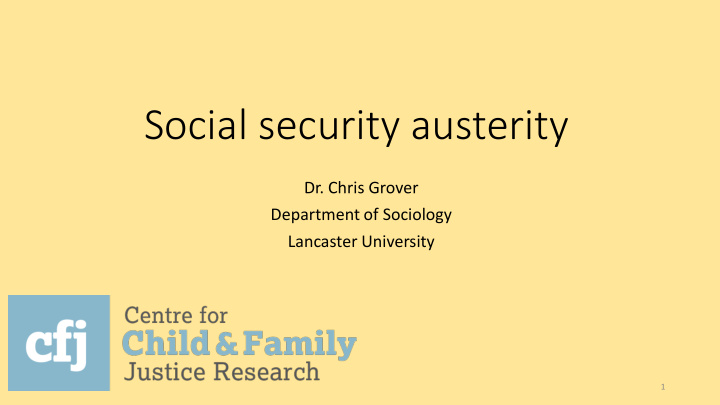



Social security austerity Dr. Chris Grover Department of Sociology Lancaster University 1
Benefit cuts • 2010 - £18 billion p.a. cuts to ‘social protection’ by 2014/15 • 2012 – further £4.5 billion p.a. by 2015 • 2015 – further £12 billion p.a. by 2020 • Ideological concerns with reducing size and scope of the state: • ‘the days of big government are over’ (HM government, 2010, p. 7) • ‘we want Britain to move from a low wage, high tax, high welfare economy to a higher wage, lower tax, lower welfare society’ (Chancellor of the Exchequer, 2015) • ‘The benefit system has created a benefit culture. It doesn’t just allow people to act irresponsibly, but often actively encourages them to do so’ (David Cameron, 2011) • worklessness • family – ‘benefit broods’ and behaviour 2
Benefit for lone mother with three children: Benefit cuts 2016 – £247 pw 2019 – £180 pw (one child born after April 2017) • Relative cuts • inflationary increases 2010-2012; 1% 2013-2015; 0% 2016-2019 • Absolute cuts – removals, restrictions and limits • e.g. removal of ‘family element’; limiting of Sure Start Maternity Grant to first child • ‘benefit cap’; ‘bedroom tax’; ‘two child limit’ • Increased conditionality – easier to lose benefits • extended – in addition to unemployed people includes: • part-time workers; lone mothers; sick and disabled people; carers • e.g. lone mothers – until 2002 no sanctioning possible until youngest child 16; from 2012 when youngest child is aged three • lengthened – lose benefits for longer periods (up to three years; indefinite sanctions for some) • Greatest impact upon: households with children; the poorest households (e.g. non-working lone mothers); households with three or more children; households with children under age of five 3
Poverty (Hood and Consequences Waters, 2017) Hunger Trussell Trust – foodbank parcels 4
Recommend
More recommend